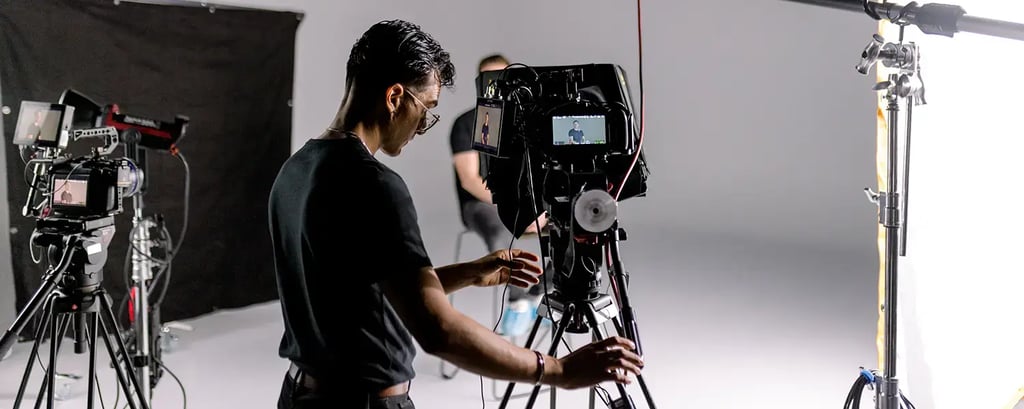Checking Out the most recent Patterns in Video Production for 2025
As we approach 2025, the video production landscape is positioned for considerable advancement, identified by developments in augmented truth and AI-driven modifying tools. The assimilation of interactive storytelling and immersive 360-degree experiences is redefining audience involvement, while sustainable production techniques obtain importance. Additionally, enhanced real-time streaming abilities are readied to democratize material access like never ever previously. These developments elevate important inquiries concerning the future of creativity and technology in video production-- what effects will these patterns hold for consumers and creators alike?
Increased Truth in Video Production
Augmented truth (AR) is poised to reinvent video production by perfectly mixing digital aspects with live-action footage. This ingenious technology improves narration by offering immersive experiences that involve viewers on a much deeper degree. AR allows filmmakers to integrate interactive graphics, computer animations, and info overlays straight right into the real-world atmosphere captured on display, creating a dynamic checking out experience that traditional techniques can not attain.
In 2025, we can expect AR to come to be an indispensable component of different video production procedures, from pre-production preparation to post-production enhancements. The capability to envision complex scenes and aspects in real-time will certainly enable directors and cinematographers to make educated choices throughout recording. In addition, AR can promote remote partnership, enabling staff member to connect with 3D versions and aesthetic results from various locations, thereby streamlining the production process.
Advertising and marketing and advertising methods will profit from AR assimilation, as brand names increasingly take advantage of this modern technology to produce one-of-a-kind and interesting web content. As customer demand for interactive and ingenious experiences remains to grow, AR will play an important role fit the future of video production, driving creativity and expanding the possibilities for filmmakers.
AI-Powered Modifying Devices
As the video production landscape evolves, AI-powered modifying devices are becoming a game changer. These devices use enhanced automation features that simplify process, help with real-time cooperation amongst groups, and existing boosted user interfaces for an extra instinctive editing experience. Recognizing these improvements is necessary for professionals looking for to stay affordable in the sector.
Boosted Automation Functions
The increase of AI-powered editing and enhancing devices is readied to reinvent the video production landscape, improving workflows and improving innovative possibilities. These enhanced automation functions are designed to lessen manual work, enabling material designers to focus a lot more on narration and imaginative vision. By leveraging artificial intelligence algorithms, these devices can assess video, identify essential moments, and recommend perfect cuts, greatly reducing editing and enhancing time.
One of the most remarkable advancements is the capacity of AI to adjust and comprehend to different editing designs. This capacity enables editors to use particular aesthetic appeals or genres to their tasks successfully, helping with a more customized method. AI-driven color grading and sound modifying devices can automatically enhance visual and audio top quality, guaranteeing a professional coating without extensive manual modifications.

Real-Time Collaboration Conveniences
Real-time collaboration is becoming increasingly important in video production, specifically with the development of AI-powered editing and enhancing tools. These cutting-edge modern technologies enable multiple stakeholders, including clients, supervisors, and editors, to interact seamlessly, despite their physical areas. By helping with instantaneous feedback and modifications, AI-powered platforms enhance the innovative process, enabling teams to make choices swiftly and effectively.
Among the key advantages of real-time collaboration is the capability to leverage AI for data-driven insights. For instance, AI formulas can examine video and suggest edits or shifts that align with the job's vision, improving the workflow. This not only increases the editing process however likewise ensures that innovative options are notified by historical data and market patterns.

Improved Individual User Interface
Cutting-edge interface in AI-powered editing tools are changing the video production landscape by enhancing the individual experience and streamlining workflows. These devices take advantage of progressed algorithms to streamline complicated editing and enhancing jobs, enabling creators to concentrate a lot more on storytelling and imagination instead of technological ins and outs.
One essential innovation is the assimilation of user-friendly drag-and-drop capabilities, which make it possible for customers to construct their tasks effortlessly. Combined with real-time responses devices, editors can picture changes instantaneously, minimizing the time spent on alterations. Furthermore, AI-driven attributes such as computerized scene detection and intelligent color grading offer recommendations based upon task context, greatly speeding up the editing and enhancing process.
Additionally, the rise of customizable interfaces enables individuals to tailor their work area to fit individual preferences, boosting productivity and effectiveness. For example, editors can focus on functions and tools they utilize usually, lessening disturbances and making the most of workflow fluidity.
As these AI-powered editing devices continue to develop, their enhanced individual interfaces are readied to redefine market standards, making high-grade video production available to a broader variety of makers. This fad not only democratizes video editing but likewise fosters advancement in content creation, setting the stage for interesting developments in 2025 and beyond.
Interactive Narration Strategies
As video production progresses, interactive storytelling strategies are becoming vital for developing immersive viewer experiences. By integrating branching narrative structures, designers can provide audiences an individualized journey through the material, improving engagement. Furthermore, real-time audience engagement permits for dynamic storytelling that adjusts to viewer options, promoting a deeper connection with the material.
Immersive Viewer Experiences
The evolution of immersive visitor experiences is transforming the landscape of interactive storytelling strategies, allowing target markets to engage with stories in extraordinary ways. By integrating virtual reality (VR), increased fact (AR), and blended fact (MR) modern technologies, creators are crafting settings where audiences do not merely observe tales however proactively participate in them. This shift towards immersion promotes a sense of existence and emotional investment, changing passive usage into vibrant exploration.
Innovations in 360-degree video and spatial sound even more boost these experiences, making it possible for users to engage and browse with their environments. Such modern technologies help with a multi-sensory approach to narration, where aesthetic and auditory components are elaborately woven with each other to develop a cohesive narrative. This not only captivates the audience yet likewise urges much deeper links to the material.
The rise of interactive platforms is equipping creators to experiment with non-linear stories, offering target markets the capability to influence results and character arcs in actual time. As immersive audience experiences continue to evolve, they are readied to redefine how stories are informed and gotten, leading the way for ingenious types of content that reverberate with diverse audiences around the world.
Branching Narrative Frameworks
Building upon the immersive customer experiences that have changed interactive storytelling, branching narrative structures are arising as an effective method to additionally engage audiences. These structures allow customers to affect the direction of the story, producing a more individualized and dynamic experience. By using multiple paths and end results, content developers can satisfy varied target market choices and foster deeper emotional connections with the product.
As innovation advances, the application of branching narratives has actually become extra sophisticated. Modern platforms allow seamless shifts between selections, boosting the audience's feeling of company. This interactivity not only astounds audiences yet additionally motivates repeated watchings, as users explore alternative storylines and endings.
Branching narratives can be efficiently integrated right into various categories, from gaming to movie and educational content. Video Production. This flexibility opens up new methods for storytelling, allowing creators to experiment with complicated character arcs and intricate stories. As we move into 2025, the value of branching narrative frameworks in video production will likely remain to grow, reshaping how tales are told and experienced, eventually redefining the connection between designers and their audiences
Real-Time Audience Involvement
Real-time audience engagement is changing interactive narration by enabling creators to get in touch with customers in unmatched means. This cutting-edge strategy enables audiences to influence stories as they unravel, improving immersion and psychological investment. With developments in technology, such as real-time polling, conversation combination, and increased fact, visitors can participate proactively, making selections that form the direction of the story in real-time.
Systems leveraging these strategies are not just redefining typical narration yet likewise cultivating neighborhood communication. By integrating features like real-time Q&A sessions and interactive personality dialogues, designers can create deeper links with their target market, guaranteeing a much more individualized watching experience. Consequently, stories end up being much more vibrant, adapting to target market feedback and preferences instantaneously.
In addition, real-time involvement improves information collection, using useful understandings right into audience actions and preferences - Corporate Video Production NYC. This details can guide future manufacturings, refining material approaches to better resonate with target demographics. As we come close to 2025, the combination of real-time audience involvement right into video production my latest blog post will likely come to be a typical practice, changing exactly how stories are told and experienced. The development of interactive narration is not simply an improvement; it is a crucial shift in the direction of a more participatory and engaging narrative structure
360-Degree Video Experiences
Immersive video experiences are established to redefine material consumption in 2025, as improvements in modern technology continue to obscure the lines in between truth and online engagement. The rise of 360-degree video and increased reality (AR) is transforming exactly how audiences communicate with content, producing opportunities for deeper emotional connections and customized narration.
With the expansion of budget friendly VR headsets and mobile devices capable of supporting premium immersive material, creators can currently produce videos that put visitors at the center of the action - Video Production NYC. This change not just boosts viewer engagement yet also permits brand names to create distinct experiences that resonate with their target audiences. For example, traveling business can supply virtual tours of locations, while universities can simulate complex settings for immersive discovering

Sustainable Production Practices
As the video production landscape evolves with cutting-edge innovations like 360-degree experiences, the industry is additionally significantly prioritizing sustainable production practices. Recognizing the ecological effect of typical filming approaches, production business are adopting environmentally friendly initiatives to decrease their carbon footprint.
One significant pattern is making use of renewable power sources, such as solar and wind power, to sustain production sets. This change not only minimizes reliance on fossil gas but likewise lowers functional costs in the lengthy run. Additionally, lots of companies are carrying out digital processes to restrict paper usage, consequently promoting a much more lasting workflow.
Moreover, the idea of a circular economic situation is gaining traction, motivating filmmakers to recycle and reuse products whenever feasible. By going with lasting set designs and costumes, production teams decrease waste and promote a culture of environmental obligation.
Partnership with local communities and companies likewise plays a necessary duty in lasting techniques, as it minimizes and promotes regional economies transportation emissions. In general, the commitment to sustainability in video production reflects a broader societal shift towards environmental stewardship, ensuring that future generations can proceed to appreciate motion picture narration without jeopardizing the planet's health.
Enhanced Real-time Streaming
The future of video production is being improved by improved live streaming capacities, which are changing exactly how audiences engage with web content. As innovation advancements, live streaming is coming to be extra easily accessible and interactive, allowing creators to get in touch with customers in real-time. This shift not just enhances target market involvement but additionally promotes a sense of area around shared experiences.
With the combination of high-def video and audio high quality, coupled with low-latency streaming, visitors now enjoy smooth broadcasts that equal conventional tv. Platforms are significantly integrating attributes such as multi-camera configurations, interactive surveys, and audience Q&A sessions, making real-time events extra appealing and vibrant.
Furthermore, the surge of decentralized streaming methods guarantees much better reliability and scalability, allowing material developers to get to larger target markets without compromising high quality. As influencers and brand names take advantage of these developments, the possibility for cutting-edge marketing methods via live streaming emerges.
In 2025, we can anticipate more developments in enhanced truth overlays and improved analytics, encouraging creators to refine their content and tailor it to audience preferences. Improved online streaming is not simply a fad; it is a crucial component forming the future of content consumption and production.
Virtual Reality Integration
With enhanced live streaming setting the stage for more interactive experiences, virtual reality (VIRTUAL REALITY) assimilation is positioned to take target market involvement to extraordinary degrees. As we come close to 2025, the merging of VR innovation with video production is transforming how content is created and consumed. By involving visitors in a 360-degree setting, manufacturers can use special experiences that conventional styles can not match.
Brands are increasingly leveraging virtual reality to develop engaging narratives that resonate deeply with target markets. This combination enables experiential marketing, where customers can engage with products or services in a digital area, promoting a more individual link. Events such as digital shows, product launches, and immersive narration sessions are ending up being commonplace, engaging customers in methods that enhance retention and psychological investment.
In addition, innovations in software and hardware are making virtual reality much more accessible to makers, leading to a broader variety of content. As production expenses lower and easy to use devices emerge, we can anticipate a surge in ingenious virtual reality projects throughout various markets, from home entertainment to education and learning. The future of video production hinges on these immersive experiences, redefining narration and target market interaction in the electronic landscape.
Frequently Asked Concerns
What Are the Essential Skills for Video Producers in 2025?
Crucial skills for video producers in 2025 consist of advanced technical effectiveness in editing software application, solid narration abilities, versatility to arising innovations, cooperation abilities for diverse teams, and a keen understanding of target market involvement strategies across systems. Video Production NYC.
Just How Can Independent Creators Accessibility Advanced Video Production Technologies?
Independent developers can access innovative video production innovations through affordable software program platforms, cloud-based modifying devices, open-source resources, and on-line courses. Cooperations with tech business and leveraging area resources likewise boost access to innovative production devices.
What Are the Potential Expenses Associated With These New Video Production Trends?
The prospective expenses connected with emerging video production trends can differ substantially, encompassing costs for innovative equipment, software application licenses, training, and employees. Budgeting effectively is vital for makers to leverage these developments without spending beyond your means.
Just How Can I Measure the Success of My Video Production Efforts?
To determine the success of your video production efforts, examine vital efficiency indicators such as viewer interaction, conversion rates, target market retention, and comments. Make use of analytics devices to collect information and acquire workable understandings for future renovations.
What Industries Are Most Impacted by Video Production Trends in 2025?
Industries such as marketing, home entertainment, education and learning, and health care are greatly influenced by arising video production fads. These markets progressively use cutting-edge strategies to improve interaction, improve interaction, and supply compelling content to their corresponding target markets.
Ingenious user interfaces in AI-powered editing and enhancing devices are transforming the video production landscape by enhancing the customer experience and enhancing workflows. As we come close to 2025, the combination of real-time audience involvement into video production will likely become a standard technique, transforming just how tales are told and experienced. As the video production landscape advances with ingenious technologies like 360-degree experiences, the market is also significantly prioritizing lasting production methods. The future of video production is being improved by improved online streaming capabilities, which are reinventing how target markets engage with web content. To measure the success of your video production initiatives, analyze crucial performance signs such as viewer interaction, conversion prices, audience retention, and responses.